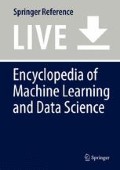Recommended Reading
Baluja S, Fahlman SE (1994) Reducing network depth in the cascade-correlation learning architecture. School of Computer Science, Carnegie Mellon University, Pittsburgh
Buckingham D, Shultz TR (2000) The developmental course of distance, time, and velocity concepts: a generative connectionist model. J Cognit Dev 1:305–345
Dandurand F, Berthiaume V, Shultz TR (2007) A systematic comparison of flat and standard cascade-correlation using a student-teacher network approximation task. Connect Sci 19:223–244
Fahlman SE (1988) Faster-learning variations on back-propagation: an empirical study. In: Touretzky DS, Hinton GE, Sejnowski TJ (eds) Proceedings of the 1988 connectionist models summer school. Morgan Kaufmann, Los Altos, pp 38–51
Fahlman SE (1991) The recurrent cascade-correlation architecture. In: Touretzky DS (ed) Advances in neural information processing systems, vol 3. Morgan Kaufmann, Los Altos
Fahlman SE, Lebiere C (1990) The cascade-correlation learning architecture. In: Touretzky DS (ed) Advances in neural information processing systems, vol 2. Morgan Kaufmann, Los Altos, pp 524–532
Mareschal D, Shultz TR (1999) Development of children’s seriation: a connectionist approach. Connect Sci 11:149–186
Oshima-Takane Y, Takane Y, Shultz TR (1999) The learning of first and second pronouns in English: network models and analysis. J Child Lang 26:545–575
Schlimm D, Shultz TR (2009) Learning the structure of abstract groups. In: Taatgen NA, Rijn HV (eds) Proceedings of the 31st annual conference of the cognitive science society. Cognitive Science Society, Austin, pp 2950–2955
Shultz TR (1998) A computational analysis of conservation. Dev Sci 1:103–126
Shultz TR (2003) Computational developmental psychology. MIT, Cambridge
Shultz TR (2006) Constructive learning in the modeling of psychological development. In: Munakata Y, Johnson MH (eds) Processes of change in brain and cognitive development: attention and performance XXI. Oxford University Press, Oxford, pp 61–86
Shultz TR, Bale AC (2006) Neural networks discover a near-identity relation to distinguish simple syntactic forms. Minds Mach 16:107–139
Shultz TR, Cohen LB (2004) Modeling age differences in infant category learning. Infancy 5:153–171
Shultz TR, Mareschal D, Schmidt WC (1994) Modeling cognitive development on balance scale phenomena. Mach Learn 16:57–86
Shultz TR, Rivest F (2001) Knowledge-based cascade-correlation: using knowledge to speed learning. Connect Sci 13:1–30
Shultz TR, Rivest F, Egri L, Thivierge J-P, Dandurand F (2007) Could knowledge-based neural learning be useful in developmental robotics? The case of KBCC. Int J Humanoid Robot 4:245–279
Shultz TR, Takane Y (2007) Rule following and rule use in simulations of the balance-scale task. Cognition 103:460–472
Shultz TR, Vogel A (2004) A connectionist model of the development of transitivity. In: Proceedings of the twenty-sixth annual conference of the cognitive science society. Erlbaum, Mahwah, pp 1243–1248
Sirois S, Shultz TR (1998) Neural network modeling of developmental effects in discrimination shifts. J Exp Child Psychol 71:235–274
Author information
Authors and Affiliations
Corresponding author
Editor information
Editors and Affiliations
Rights and permissions
Copyright information
© 2014 Springer Science+Business Media New York
About this entry
Cite this entry
R.Shultz, T., E.Fahlman, S. (2014). Cascade-Correlation. In: Sammut, C., Webb, G. (eds) Encyclopedia of Machine Learning and Data Mining. Springer, Boston, MA. https://doi.org/10.1007/978-1-4899-7502-7_33-1
Download citation
DOI: https://doi.org/10.1007/978-1-4899-7502-7_33-1
Received:
Accepted:
Published:
Publisher Name: Springer, Boston, MA
Online ISBN: 978-1-4899-7502-7
eBook Packages: Springer Reference Computer SciencesReference Module Computer Science and Engineering
Publish with us
Chapter history
-
Latest
Cascade–Correlation- Published:
- 27 April 2022
DOI: https://doi.org/10.1007/978-1-4899-7502-7_33-2
-
Original
Cascade-Correlation- Published:
- 17 February 2015
DOI: https://doi.org/10.1007/978-1-4899-7502-7_33-1

